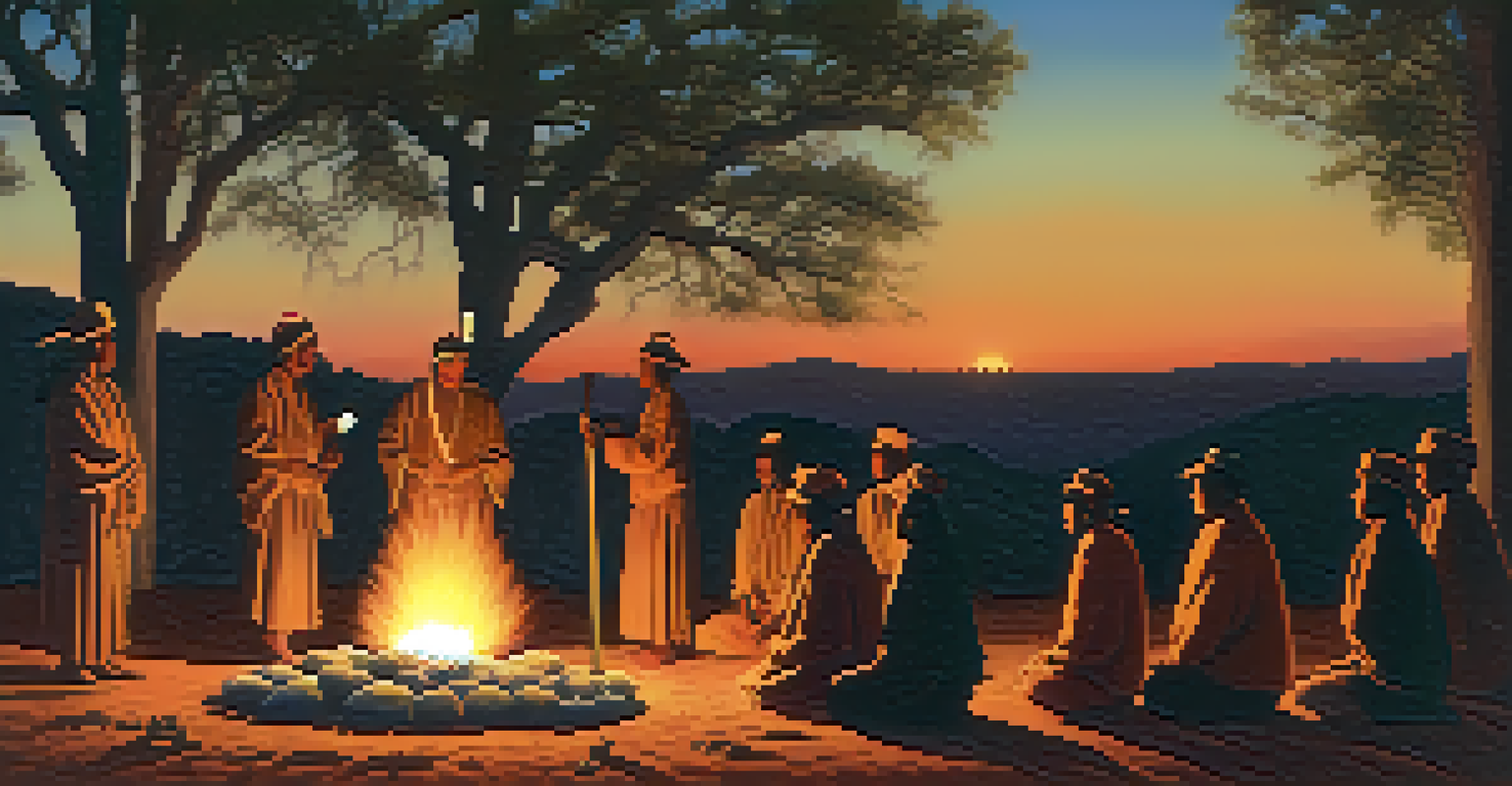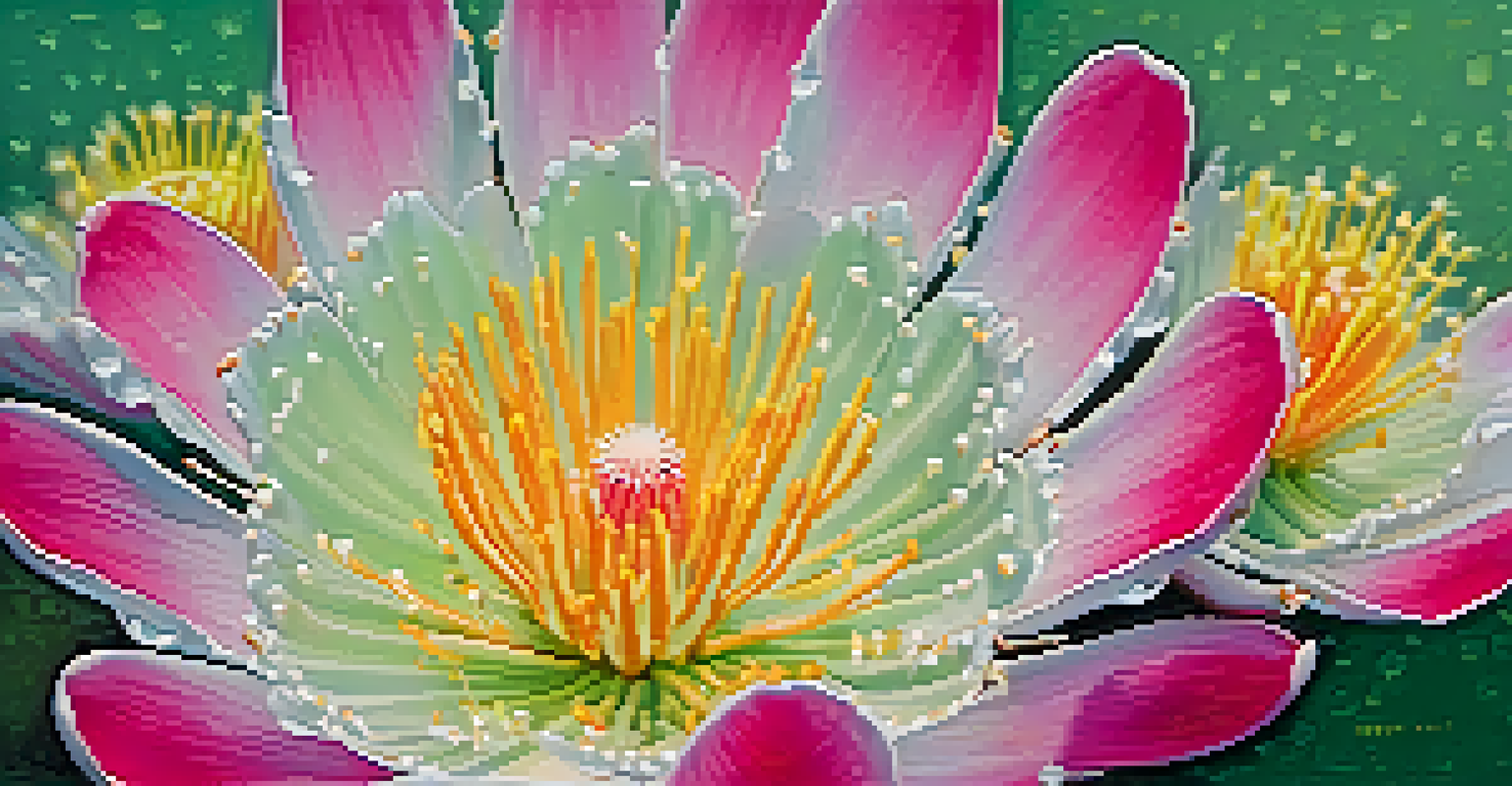Cultural Significance of Peyote in Indigenous Healing Rituals

Understanding Peyote: A Brief Overview
Peyote, a small cactus native to North America, contains the psychoactive compound mescaline. This plant has been used for centuries by Indigenous peoples in various regions, particularly in Mexico and the southwestern United States. It serves not only as a spiritual sacrament but also as a key component in healing rituals.
Psychedelics can help us confront the deepest parts of ourselves, unlocking insights that lead to personal transformation.
The use of peyote is deeply rooted in the traditions of many Native American tribes, where it is seen as a gift from the Creator. Through its effects, peyote helps facilitate a connection to the spiritual realm, allowing individuals to gain insights into their lives and the world around them. This connection is essential for personal and communal healing.
In these contexts, peyote is more than just a substance; it embodies cultural identity and spiritual heritage. It is integral to ceremonies that promote healing, introspection, and community bonding, showcasing the rich tapestry of Indigenous spiritual practices.
Historical Context of Peyote in Indigenous Cultures
The historical significance of peyote can be traced back thousands of years, with archaeological evidence suggesting its use as far back as 5,700 years ago. Indigenous peoples have long recognized the plant's powerful effects and have incorporated it into their spiritual beliefs and healing practices. This deep-rooted history highlights the importance of peyote in maintaining cultural continuity.

Different tribes have developed unique rituals surrounding peyote use, often involving music, prayer, and communal gatherings. These ceremonies serve not only as healing mechanisms but also as vital cultural events that strengthen community bonds. The experience of consuming peyote is typically guided by a spiritual leader, who ensures that participants gain the most from the experience.
Therapeutic Potential of Peyote
Research suggests that mescaline, the active compound in peyote, may offer mental health benefits, prompting discussions on integrating traditional practices with modern therapy.
As Indigenous cultures faced colonization and oppression, the peyote ritual became a symbol of resistance and resilience. Today, it stands as a testament to the enduring strength of these communities and their commitment to preserving their traditions in the face of adversity.
The Role of Peyote in Healing Practices
In the context of healing, peyote is often used to address both physical and spiritual ailments. Participants in peyote ceremonies report experiencing profound emotional releases, insights into personal struggles, and an overall sense of well-being. This holistic approach to healing resonates deeply within Indigenous worldviews, which emphasize the interconnectedness of mind, body, and spirit.
The use of peyote is not merely a ritual; it is a profound journey into the self and the spirit, connecting us with our heritage and ancestors.
The healing process facilitated by peyote can be transformative, leading individuals to confront and work through trauma, addiction, and other challenges. It encourages introspection and self-discovery, allowing participants to gain clarity and insight that might be difficult to access in everyday life. This transformative experience is often described as a 'journey' into oneself.
Moreover, the communal aspect of peyote ceremonies fosters a sense of belonging and support among participants. Sharing stories and experiences during these rituals helps individuals feel understood and connected, reinforcing the idea that healing is not just an individual journey but a communal one.
Peyote and Spiritual Connection
For many Indigenous peoples, the use of peyote is fundamentally linked to spirituality. During ceremonial use, participants often report experiencing profound spiritual awakenings and connections to their ancestors. This spiritual dimension is crucial, as it frames the use of peyote within a larger cosmology that values the interconnectedness of all life.
The rituals surrounding peyote consumption often include prayers, singing, and drumming, which enhance the spiritual atmosphere and facilitate deeper experiences. These practices help create a sacred space where individuals can seek guidance, healing, and communion with the divine. The intention behind these rituals is to honor the plant as a sacred gift.
Peyote's Cultural Significance
Peyote is a vital component of Indigenous spiritual practices, serving as a means of healing and cultural identity.
This spiritual connection not only aids in personal healing but also reinforces cultural identity and continuity. By engaging in peyote rituals, individuals reaffirm their ties to their heritage and the wisdom of their ancestors, ensuring that these traditions are passed down to future generations.
Contemporary Issues Surrounding Peyote Use
In recent years, the use of peyote has faced various challenges, particularly due to legal restrictions and environmental concerns. As more people become interested in psychedelics for therapeutic purposes, the demand for peyote has increased, leading to concerns about overharvesting. This poses a significant threat to the natural populations of peyote, which are already vulnerable.
Additionally, the appropriation of peyote rituals by non-Indigenous individuals raises ethical questions. It is essential to respect the cultural significance of peyote use and to understand that these practices are deeply rooted in specific Indigenous traditions. Engaging with these practices should be approached with respect and a genuine desire to learn.
Indigenous communities continue to advocate for the protection of their traditions and the sustainable use of peyote. As awareness grows about the importance of preserving these practices, there is hope that more people will recognize the need for respectful engagement and support for Indigenous rights.
Peyote in Modern Therapeutic Practices
As interest in psychedelics for therapeutic use has surged, peyote has garnered attention for its potential benefits in mental health treatment. Research indicates that substances like mescaline can help alleviate symptoms of depression, anxiety, and PTSD. This has sparked a growing conversation about integrating traditional Indigenous knowledge with modern therapeutic practices.
However, it's crucial to approach this intersection with caution and respect. While the therapeutic potential of peyote is promising, it must be acknowledged that its use is deeply spiritual for Indigenous peoples. The focus should be on framing these discussions within the context of cultural respect and understanding.
Challenges Facing Peyote Use
Legal restrictions and environmental threats pose significant challenges to the traditional use of peyote among Indigenous communities.
Collaborative efforts between researchers and Indigenous communities can pave the way for more comprehensive studies that honor traditional practices while exploring modern applications. This partnership can lead to a more nuanced understanding of peyote's role in both healing and cultural identity.
The Future of Peyote in Indigenous Practices
Looking ahead, the future of peyote in Indigenous healing rituals will depend on the balance between preservation and adaptation. As younger generations seek to engage with their cultural heritage, there is potential for innovation in how peyote is utilized within healing practices. This evolution could foster a renewed sense of identity and purpose.
Moreover, ongoing advocacy for the protection of peyote and its traditional uses remains critical. Engaging in conversations about sustainability, legal rights, and cultural preservation will be essential for ensuring that peyote continues to play a vital role in Indigenous healing practices for years to come.

Ultimately, the journey of peyote within Indigenous cultures illustrates the resilience of these communities and their commitment to maintaining their unique identities. By acknowledging and respecting the significance of peyote, we can support a future where these healing practices thrive and continue to enrich lives.